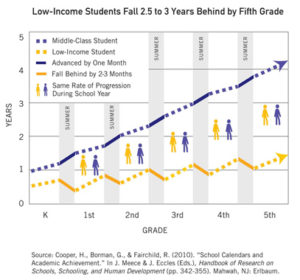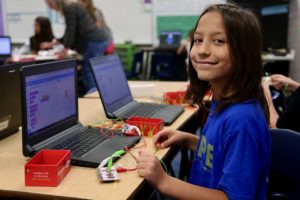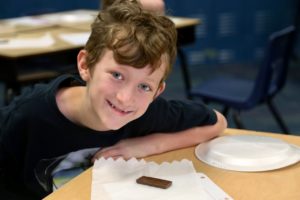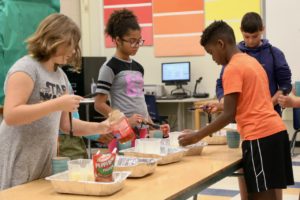Free to Learn: STEM Camp vs The ‘Summer Slide’
A few years back, leaders from the Hurst-Euless-Bedford Independent School District came to 6 Stones with a dream: we want to run a Science, Technology, Engineering, and Mathematics (STEM) Camp in the summer. And we want it to be open to anyone who wants to come, regardless of their income level. So we asked some of our biggest donors to consider a contribution to the launch fund for just such a program. The resulting gifts made STEM Camp available to nearly 1,000 kids over the last four years.
“At-risk” kids make up a good portion of the specialized camp. Some students can afford to pay full price for the two-week experience. Others come from families that might not eat without the program, which includes breakfast and lunch for every camper as well as any parent who needs to join them. Those families pay just $20 per week for four hours of laboratory experience, computer coding, and hands-on engineering spread over eight days in June. The program’s seed money covers the rest of their tuition, making it possible for any student in HEB ISD to get the most out of their summer vacation.
For those kids — many of whom are depending on us for school supplies at the end of the summer — the STEM Camp experience is invaluable.
Combating the “Summer Slide”
If you spend enough time with a teacher or School District employee, you’ll hear them talk about the “summer slide.” Educators are increasingly aware of the fact that students tend to lose knowledge and skills during their vacation. That pattern disproportionately affects economically disadvantaged kids, who don’t have access to the same educational resources as their more affluent peers. In a district as diverse as HEB ISD, that’s a huge problem.

How the “Summer Slide” affects students from varying economic backgrounds, via gradelevelreading.net.
Maryann White, who oversees the district’s Extended Day programs as well as the new STEM Camp, thinks the solution is simple: make school fun again.
“Your scores are a certain thing, your abilities are in a certain place. As the summer wears on, you’re not reading at home — not as much as you were — you’re not doing the homework,” White said. “You kind of slide a little bit, you kind of start forgetting things. It’s kind of like adults: we don’t read very much. It’s a little bit harder, maybe we don’t like it as much. But the kids, as long as we can keep them engaged, keep them here, and give them those special opportunities, their brain power continues to grow over the summer and not slide or decline.”
Kids — like anyone else — need to practice to keep their skills sharp. But White and her team didn’t want the kids to just sit under fluorescent lights doing homework all summer. They wanted to see students (and teachers) get excited about learning.
Hands-On Means Brains-On
When recruiting teachers for STEM Camp, White keeps her pitch simple: the sky’s the limit. You can make as big a mess and as many bold choices as you want in a summer classroom. In the first year of the program, more than 40 faculty members submitted proposals for a two-week course. Only about half of those ideas became actual classes, but some are still in circulation as the most popular options at registration today.

STEM Camp students use electrical engineering and computer programming to turn everyday objects into musical instruments.
STEM Camp students get to select four classes from a list of twenty before being assigned to two 90-minute labs; one in the morning and one in the afternoon. They have a wide assortment from which to choose: robotics, electrical engineering, architecture, and even a few specialty classes on the mathematical principles behind everyday experiences like cooking and board games. But, according to “Forensic Science Detectives” instructor Lisa Boucher-Hill, every class has one thing in common:
“It’s all hands-on. Everything is engaging; everything is about them doing it. That’s the fun part about the class!” said Boucher-Hill, who teaches 4th Grade Math and Science at Viridian Elementary during the school year. “I think that’s important in anything kids do. That’s what science is; it’s hands-on and engaging… that’s what makes school fun, anyway: the kids learning. Teachers should be the facilitator, kids should be the ones that are engaging and interacting. That’s how kids learn today.”
In any one of twenty STEM Camp classrooms, the kids are responsible for their own learning. The classes themselves are well-directed and well-organized, of course, but creative freedom is woven into their design. At camp, as in any STEM career, experimentation and exploration rule.
Overcoming the Fear of Failure
Nearly every teacher we interviewed talked about the need for a little freedom and fun in the classroom. They're quick to point out that standardized testing and rigid curriculum take over a normal classroom. Most of them emphasized the joy of a classroom devoid of test anxiety or rigid state guidelines as a key reason they keep teaching during summer break. Lea Brown, the Gifted/Talented teacher at Bell Manor Elementary, made a point to connect creativity with a larger issue. Kids who don’t create will never learn to operate independently.
“In 19 years of teaching, I’ve seen that children have become more insecure about their own thinking. I think the nature of how education has become — we’ve had to micromanage them so much — it’s very difficult for them to think on their own. To think freely, and to make decisions that they trust. I think it’s a big loss; it’s actually affecting some of our Big Picture worries. They are so afraid of doing things wrong that they do things wrong!” Brown said.

In the “Forensic Science Detectives” class, students use clues — like this chocolate bar bite mark analysis — to solve mysteries using science.
“I think it’s really good to be able to let them experience a little failure and how that failure creates success.”
Of all the academic disciplines, Science and Mathematics may be the most valuable in that regard. Within those fields, some measure of failure is almost expected. We learn by trial and error; by observing and adjusting between attempts to solve a problem. Kids who grow up only following rules and directions lose out on those skills.
“I think it’s a great opportunity for the kids to be able to think for once, without worrying what the teacher thinks. They’re not getting graded, they’re not getting tested. They walk in, they have a problem, and they get to solve it,” said Derek Thorn, an industrial-chemist-turned-educator who teaches robotics at the Buinger Career and Technical Education Center as well as STEM Camp.
“That’s all engineering is; solving a problem that maybe nobody has solved before.”
The Bigger Picture
This community is used to solving problems in creative ways. More than half of our kids qualify for free or reduced lunch. Together we’ve been able to keep them equipped for school. Recent survey data shows that 44% of students in HEB ISD are considered at-risk of dropping out. 98% graduate on time. That doesn’t just happen. It’s the by-product of a district that strives to keep kids on equal footing. A goal made possible by a generous community.
In the case of STEM Camp, it was a few generous donors following one nonprofit in starting something big.

Some classes are more practical, showing the mathematical concepts behind normal experiences like cooking or playing board games.
“We filled up and had a waiting list the first year. Kids were excited, parents were excited. We offered a low cost. We did have some seed money given to us, which was wonderful. 6 Stones [facilitated that],” White said. “That seed continued to grow, and as that seed grew we were able to help our underprivileged children… the kids, because of that seed money, were able to come to a camp that they may never have been able to go to before.”
STEM Camp, like every 6 Stones program, started with a simple formula. The district identified a need and brought it to us. We put the community in a position to meet that need, and the community stepped up. The camp runs independently of 6 Stones, but it reflects our vision for this community to be one where neighbors support one another.
Whether that support comes in the form of a $35 donation to provide a backpack and school supplies to a single child or thousands of dollars in seed money for a program like STEM Camp, it sends a clear message to the next generation. Because this community is behind them, they will be defined by their effort, not their resources.
You can send that message, too! Operation Back 2 School gives everyone the opportunity to invest in local kids. You can sponsor one student’s school year or find out more about STEM Camp and get involved with the next generation today.

Is it free? Or do you have to pay money? Or is it canceled because of Covid-19?
That post was from 2019. We do not have the camp this year.